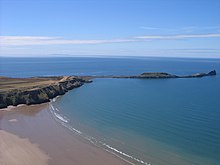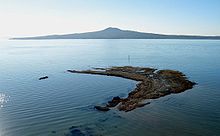Tidal island
This article needs additional citations for verification. (October 2023) |



A tidal island is a raised area of land within a waterbody, which is connected to the larger mainland by a natural isthmus or man-made causeway that is exposed at low tide and submerged at high tide, causing the land to switch between being a promontory/peninsula and an island depending on tidal conditions.
Because of the mystique surrounding tidal islands, many of them have been sites of religious worship, such as Mont-Saint-Michel with its Benedictine Abbey. Tidal islands are also commonly the sites of fortresses because of the natural barrier created by the tidal channel.
List of tidal islands[edit]
Asia[edit]
Hong Kong[edit]
- Ma Shi Chau in Tai Po District, northeastern New Territories, within the Tolo Harbour
- Kiu Tau Island in Sai Kung
Iran[edit]
- Naaz islands in Persian gulf, southern seashore of Qeshm island
Japan[edit]
Taiwan[edit]
- Kueibishan in Penghu
- Jiangong Islet in Kinmen
South Korea[edit]
- Jindo Island and Modo Island in southwest South Korea
- Jebudo in the west
Europe[edit]
Denmark[edit]
- Mandø Island – on Denmark's western coast
- Knudshoved Island – north of Vordingborg on southern Zealand, Denmark
Denmark/Germany[edit]
- The Halligen in the North Frisian Islands, Denmark/Germany
France[edit]

- Île Aganton in Brittany
- Île Madame in Charente-Maritime
- Île de Noirmoutier in Vendée
- Mont Saint-Michel in Normandy
- Tombelaine in Normandy
Germany[edit]
- The Neuwerk in the Wadden Sea
Guernsey[edit]
- Lihou in Guernsey, one of the Channel Islands
Iceland[edit]
Grótta in Seltjarnarnes, the Capital Region
Ireland[edit]
- Coney Island near Rosses Point, County Sligo
- Omey Island in Connemara, County Galway
- Inishkeel, County Donegal
Italy[edit]
- Isola Grande, Sicily
Jersey[edit]
- Elizabeth Castle in Jersey, a castle off the south coast accessible on foot at low tide
- Saint Aubin's Fort
- La Corbière Lighthouse
- La Motte, Jersey, alias Green Island
- L'Avarison, which hosts Seymour Tower
- Archirondel Tower, now connected via permanent causeway
- Icho Tower
- Portelet Tower
Spain[edit]
- Cortegada Island in Pontevedra coast, Galicia.
- San Nikolas Island in Lekeitio, Bizkaia
United Kingdom[edit]


England[edit]
- Asparagus Island, Mount's Bay, Cornwall
- Burgh Island, Devon
- Burrow Island, Portsmouth Harbour
- Chapel Island, Cumbria
- Chiswick Eyot in the River Thames in London
- Gugh in the Isles of Scilly (joined to St Agnes at low tide)
- Hilbre Island, Middle Eye and Little Eye in the River Dee estuary, between North Wales and the English Wirral, but administratively in England.
- Horsey Island, Essex
- Lindisfarne, Northumberland, also known as Holy Island
- Mersea Island, Essex (accessible to road traffic via the Strood)
- Northey Island, Essex
- Osea Island, Essex
- Piel Island, Cumbria
- Scolt Head Island, Norfolk
- Sheep Island, Cumbria (joined at low tide to Piel Island and to Walney Island)
- St Mary's Island, North Tyneside
- St Michael's Mount, Cornwall
- White Island, Isles of Scilly and St Martin's, Isles of Scilly
Northern Ireland[edit]

- Nendrum Monastery on Mahee Island, Strangford Lough
- Guns Island, near Ballyhornan
- Isle of Muck, Portmuck
Scotland[edit]
- Baleshare in the Outer Hebrides, joined to North Uist
- Bernera Island, joined to Lismore
- Brough of Birsay in Orkney, joined to Orkney Mainland
- Castle Stalker on Loch Laich in Argyll
- Cramond Island in the Firth of Forth
- Island Davaar near Campbeltown, off the Kintyre peninsula
- Eilean Donan in the western Highlands of Scotland
- Eilean Fladday and Eilean Tigh off the Isle of Raasay
- Eilean Shona in Loch Moidart, Lochaber, Highland
- Eilean Tioram, in Loch Moidart
- Erraid off the Isle of Mull
- Hestan Island near Rough Island in Auchencairn Bay
- Islands of Fleet: Ardwall Isle and Barlocco Isle in Galloway
- Isle Ristol, the innermost of the Summer Isles
- Kili Holm in Orkney, joined to Egilsay
- Oronsay in the Inner Hebrides, joined to Colonsay
- Oronsay in Loch Bracadale, joined to Skye
- Orosay in the Outer Hebrides, joined to Barra
- Rough Island opposite Rockcliffe, Dumfries & Galloway
- Vallay (Bhàlaigh), joined to North Uist in the Outer Hebrides
Wales[edit]
- Burry Holms off the Gower
- Cribinau off Anglesey
- Gateholm off the south west coast of Pembrokeshire
- Ynys Llanddwyn off Anglesey
- Mumbles Lighthouse located in Mumbles, near Swansea
- St Catherine's Island in Pembrokeshire
- Sully Island in the Vale of Glamorgan
- Worm's Head at the end of the Gower
- Ynys Cantwr off Ramsey Island, Pembrokeshire
- Ynys Feurig off Anglesey
- Ynys Gifftan in Gwynedd
- Ynys Gwelltog off Ramsey Island, Pembrokeshire
- Ynys Lochtyn on the coast of Cardigan Bay
43 (unbridged) tidal islands can be walked to from the UK mainland.[1]
North America[edit]
Canada[edit]
- Finisterre Island off of Bowen Island, British Columbia, Canada
- Francis Peninsula off of Sunshine Coast (British Columbia), British Columbia, Canada
- Micou's Island in St. Margarets Bay, Nova Scotia, Canada
- Minister's Island in New Brunswick, Canada
- Ross Island and Cheney Island in Grand Manan, New Brunswick, Canada
- Wedge Island, Nova Scotia, Canada
- Whyte Islet in West Vancouver, British Columbia, Canada
- Bird Islet in Neck Point Park, Nanaimo, British Columbia, Canada
United States[edit]

- Bar Island in Maine
- Battery Point Light in California
- Bumpkin Island in Massachusetts
- Camano Island in Puget Sound of Washington state, since earth filled
- Charles Island, in Connecticut
- Douglas Island in Alaska
- High Island, New York
- Long Point Island,[2] Harpswell, Maine
- Tskawahyah Island of Cape Alava, Washington
Oceania[edit]
Australia[edit]
- The Point Walter Sandbar in Perth, Western Australia has slowly formed into a tidal island and is only connected to the mainland in extreme low tides.
- Penguin Island (Western Australia) in the Shoalwater Islands Marine Park
- Former tidal island Bennelong Island in Sydney, Australia was developed into Bennelong Point and is now the location of the Sydney Opera House.
New Zealand[edit]

- Matakana Island in Tauranga Harbour
- Opahekeheke Island in the Kaipara Harbour
- Puddingstone Island in Otago Harbour
- Rabbit Island, Bells Island, and Bests Island in Tasman Bay
- The Hauraki Gulf islands of Motutapu Island and Rangitoto Island are connected at low tide
- The Okatakata Islands in Rangaunu Harbour
See also[edit]
References[edit]
- ^ Peter Caton (2011). No Boat Required – Exploring Tidal Islands. Troubador Publishing Limited. ISBN 978-1848767-010.
- ^ longpointisland.com Archived 2007-09-27 at the Wayback Machine
External links[edit]
 Media related to Tidal islands at Wikimedia Commons
Media related to Tidal islands at Wikimedia Commons


 French
French Deutsch
Deutsch
